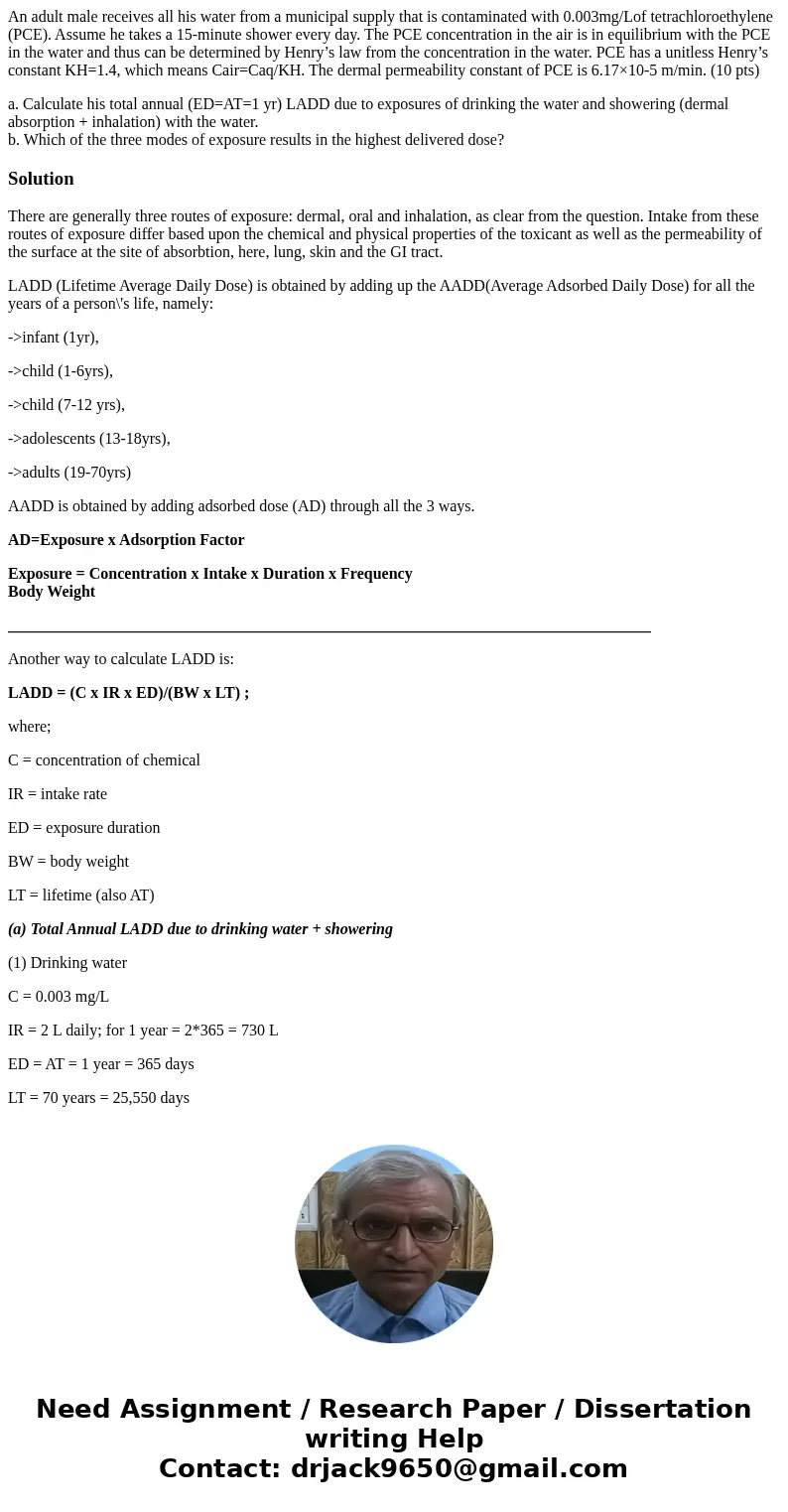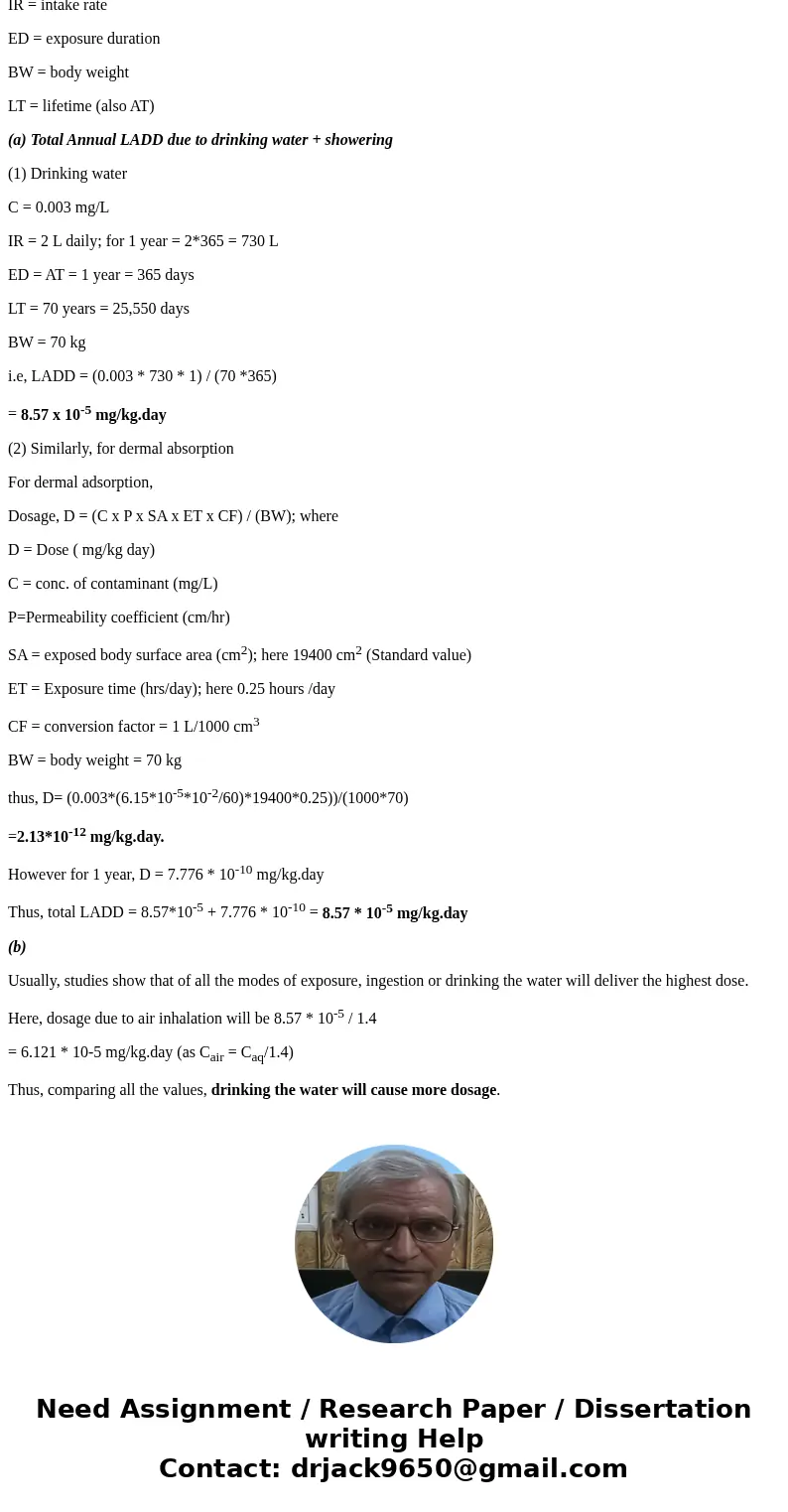An adult male receives all his water from a municipal supply
An adult male receives all his water from a municipal supply that is contaminated with 0.003mg/Lof tetrachloroethylene (PCE). Assume he takes a 15-minute shower every day. The PCE concentration in the air is in equilibrium with the PCE in the water and thus can be determined by Henry’s law from the concentration in the water. PCE has a unitless Henry’s constant KH=1.4, which means Cair=Caq/KH. The dermal permeability constant of PCE is 6.17×10-5 m/min. (10 pts)
a. Calculate his total annual (ED=AT=1 yr) LADD due to exposures of drinking the water and showering (dermal absorption + inhalation) with the water.
b. Which of the three modes of exposure results in the highest delivered dose?
Solution
There are generally three routes of exposure: dermal, oral and inhalation, as clear from the question. Intake from these routes of exposure differ based upon the chemical and physical properties of the toxicant as well as the permeability of the surface at the site of absorbtion, here, lung, skin and the GI tract.
LADD (Lifetime Average Daily Dose) is obtained by adding up the AADD(Average Adsorbed Daily Dose) for all the years of a person\'s life, namely:
->infant (1yr),
->child (1-6yrs),
->child (7-12 yrs),
->adolescents (13-18yrs),
->adults (19-70yrs)
AADD is obtained by adding adsorbed dose (AD) through all the 3 ways.
AD=Exposure x Adsorption Factor
Exposure = Concentration x Intake x Duration x Frequency
Body Weight
_________________________________________________________________________________
Another way to calculate LADD is:
LADD = (C x IR x ED)/(BW x LT) ;
where;
C = concentration of chemical
IR = intake rate
ED = exposure duration
BW = body weight
LT = lifetime (also AT)
(a) Total Annual LADD due to drinking water + showering
(1) Drinking water
C = 0.003 mg/L
IR = 2 L daily; for 1 year = 2*365 = 730 L
ED = AT = 1 year = 365 days
LT = 70 years = 25,550 days
BW = 70 kg
i.e, LADD = (0.003 * 730 * 1) / (70 *365)
= 8.57 x 10-5 mg/kg.day
(2) Similarly, for dermal absorption
For dermal adsorption,
Dosage, D = (C x P x SA x ET x CF) / (BW); where
D = Dose ( mg/kg day)
C = conc. of contaminant (mg/L)
P=Permeability coefficient (cm/hr)
SA = exposed body surface area (cm2); here 19400 cm2 (Standard value)
ET = Exposure time (hrs/day); here 0.25 hours /day
CF = conversion factor = 1 L/1000 cm3
BW = body weight = 70 kg
thus, D= (0.003*(6.15*10-5*10-2/60)*19400*0.25))/(1000*70)
=2.13*10-12 mg/kg.day.
However for 1 year, D = 7.776 * 10-10 mg/kg.day
Thus, total LADD = 8.57*10-5 + 7.776 * 10-10 = 8.57 * 10-5 mg/kg.day
(b)
Usually, studies show that of all the modes of exposure, ingestion or drinking the water will deliver the highest dose.
Here, dosage due to air inhalation will be 8.57 * 10-5 / 1.4
= 6.121 * 10-5 mg/kg.day (as Cair = Caq/1.4)
Thus, comparing all the values, drinking the water will cause more dosage.


 Homework Sourse
Homework Sourse